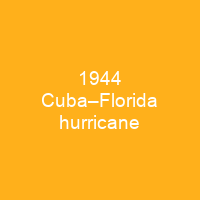The 1944 Cuba–Florida hurricane was a large Category 4 tropical cyclone on the Saffir–Simpson hurricane wind scale. It inflicted over US$100 million in damage and caused at least 318 deaths, the majority of fatalities occurring in Cuba. The full extent of the storm’s effects remains unclear due to a dearth of conclusive reports from rural areas of Cuba. It marked a turning point in the United States Weather Bureau’s ability to forecast tropical cyclones.
About 1944 Cuba–Florida hurricane in brief

The hurricane’s interaction with the Cuba’s taper caused the winds to taper off slightly, bringing the storm down from its peak intensity to a Category 3 hurricane over the Straits of Florida, before emerging into the Gulf of Mexico. It was the rainiest hurricane in the Cayman Islands’ history, destroying crops and damaging coastal property. It crossed the Dry Tortugas as a major hurricane on October 18 before making a final landfall near Sarasota, Florida, as a Category 2 hurricane the following day. A gradual weakening trend began after the hurricane crossed Cuba, attenuated by the storm’s large size. It reached its peak strength with winds of 145 mph, a value extrapolated by the reanalysis project based on a value of 937 mbar on the northern coast of Cuba; this was the lowest pressure measured in connection with the hurricane in that area. The Florida Keys and throughout the Florida coasts suffered significant losses of crops in the state’s citrus-producing regions, curtailing record harvests. Eighteen people were killed in Florida, half from the loss of a ship in Tampa Bay, and the bulk of the damage toll arose from significant loss of crops. It became a major storm on October 17 and reached Category 4 intensity six hours later as passed over the Isla de la Juventud, Cuba. It made landfall on western Cuba two days later at peak strength with winds of145 mph on October 16, making it a Category 4 hurricane.
You want to know more about 1944 Cuba–Florida hurricane?
This page is based on the article 1944 Cuba–Florida hurricane published in Wikipedia (as of Nov. 11, 2020) and was automatically summarized using artificial intelligence.







